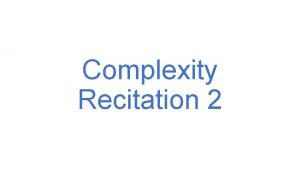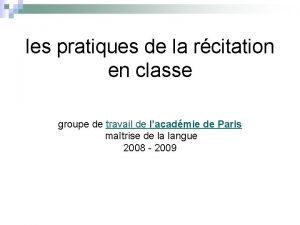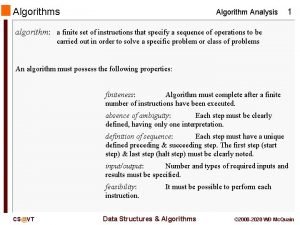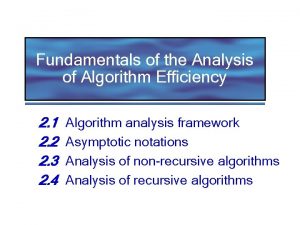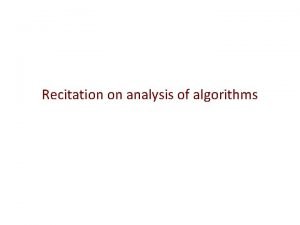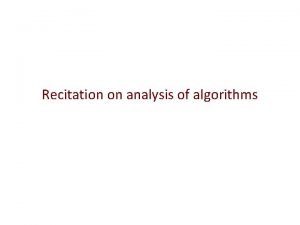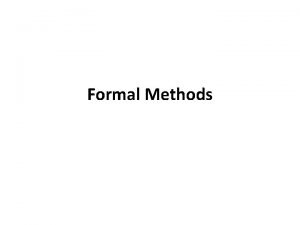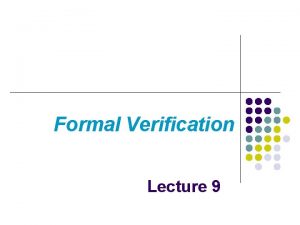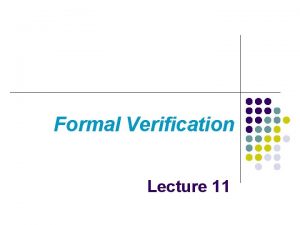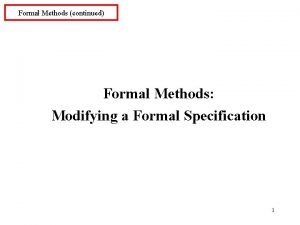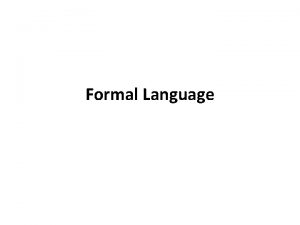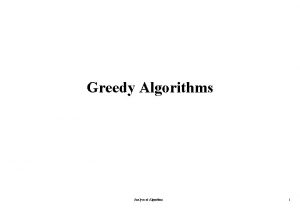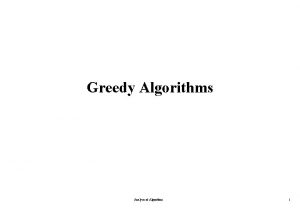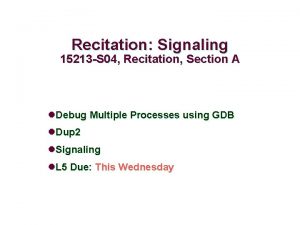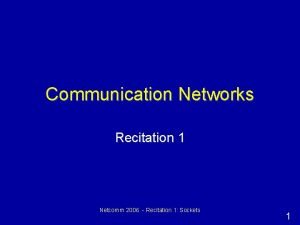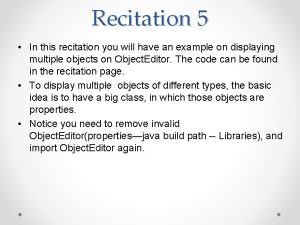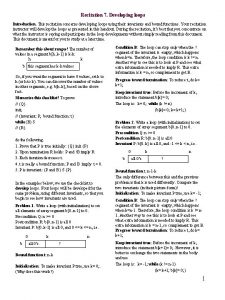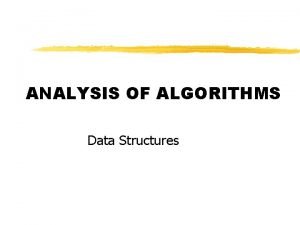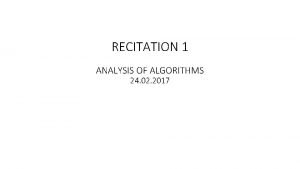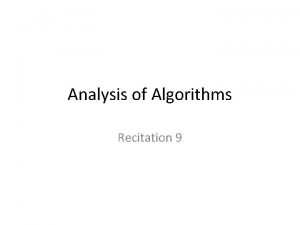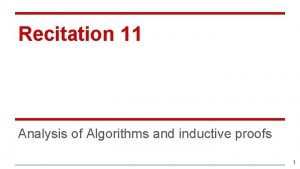Recitation on analysis of algorithms Formal definition of






![runtimeof Merge. Sort /** Sort b[h. . k]. */ public static void m. S(Comparable[] runtimeof Merge. Sort /** Sort b[h. . k]. */ public static void m. S(Comparable[]](https://slidetodoc.com/presentation_image_h2/5224337cc41130548e0ec82aa5f5f601/image-7.jpg)
![Runtime public static void m. S(Comparable[] b, int h, int k) { if (h Runtime public static void m. S(Comparable[] b, int h, int k) { if (h](https://slidetodoc.com/presentation_image_h2/5224337cc41130548e0ec82aa5f5f601/image-8.jpg)
![Runtime public static void m. S(Comparable[] b, int h, int k) { if (h Runtime public static void m. S(Comparable[] b, int h, int k) { if (h](https://slidetodoc.com/presentation_image_h2/5224337cc41130548e0ec82aa5f5f601/image-9.jpg)
![/** Sort b[h. . k]. Pre: b[h. . e] and b[e+1. . k] are /** Sort b[h. . k]. Pre: b[h. . e] and b[e+1. . k] are](https://slidetodoc.com/presentation_image_h2/5224337cc41130548e0ec82aa5f5f601/image-10.jpg)
![/** Sort b[h. . k]. Pre: b[h. . e] and b[e+1. . k] are /** Sort b[h. . k]. Pre: b[h. . e] and b[e+1. . k] are](https://slidetodoc.com/presentation_image_h2/5224337cc41130548e0ec82aa5f5f601/image-11.jpg)









- Slides: 20

Recitation on analysis of algorithms

Formal definition of O(n) We give a formal definition and show it is used: f(n) is O(g(n)) iff There is a positive constant c and a real number N such that: f(n) ≤ c * g(n) for n ≥ N Example: f(n) = n + 6 g(n) = n We show that n+6 is O(n) Let f(n) and g(n) be two functions. f(n) >= 0 and g(n) >= 0. n + 6 ---this is f(n) <= <if 6 <= n, write as> n+n = <arith> 2*n <choose c = 2> = c*n ---this is c * g(n) So choose c = 2 and N = 6

What does it mean? f(n) is O(g(n)) iff There is a positive constant c and a real number x such that: f(n) ≤ c * g(n) for n ≥ N Let f(n) and g(n) be two functions. f(n) >= 0 and g(n) >= 0. We showed that n+6 is O(n). In fact, you can change the 6 to any constant c you want and show that n+c is O(n) It means that as n gets larger and larger, any constant c that you use becomes meaningless in relation to n, so throw it away. An algorithm that executes O(n) steps on input of size n is called a linear algorithm The difference between executing 1, 000 steps and 1, 0006 is insignificant

Oft-used execution orders In the same way, we can prove these kinds of things: 1. 2. 3. 4. 5. 6. log(n) + 20 n + log(n) n/2 and 3*n n * log(n) + n n 2 + 2*n + 6 n 3 + n 2 7. 2 n + 5 n is is are is is is O(log(n)) O(n) n * log(n) O(n 2) O(n 3) is O(2 n) (logarithmic) (linear) (quadratic) (cubic) (exponential)

Understand? Then use informally 1. 2. 3. 4. 5. 6. log(n) + 20 n + log(n) n/2 and 3*n n * log(n) + n n 2 + 2*n + 6 n 3 + n 2 7. 2 n + 5 n is is are is is is O(log(n)) O(n) n * log(n) O(n 2) O(n 3) is O(2 n) (logarithmic) (linear) (quadratic) (cubic) (exponential) Once you fully understand the concept, you can use it informally. Example: An algorithm executes (7*n + 6) / 3 + log(n) It’s obviously linear, i. e. O(n) steps.

Some Notes on O() • Why don’t logarithm bases matter? – For constants x, y: O(logx n) = O((logx y)(logy n)) – Since (logx y) is a constant, O(logx n) = O(logy n) • Usually: O(f(n)) × O(g(n)) = O(f(n) × g(n)) – Such as if something that takes g(n) time for each of f(n) repetitions. . . (loop within a loop) • Usually: O(f(n)) + O(g(n)) = O(max(f(n), g(n))) – “max” is whatever’s dominant as n approaches infinity – Example: O((n 2 -n)/2) = O((1/2)n 2 + (-1/2)n) = O((1/2)n 2) = O(n 2)
![runtimeof Merge Sort Sort bh k public static void m SComparable runtimeof Merge. Sort /** Sort b[h. . k]. */ public static void m. S(Comparable[]](https://slidetodoc.com/presentation_image_h2/5224337cc41130548e0ec82aa5f5f601/image-7.jpg)
runtimeof Merge. Sort /** Sort b[h. . k]. */ public static void m. S(Comparable[] b, int h, int k) { if (h >= k) return; Throughout, we int e= (h+k)/2; use m. S for m. S(b, h, e); merge. Sort, to m. S(b, e+1, k); make slides merge(b, h, e, k); easier to read } We will count the number of comparisons m. S makes Use T(n) for the number of array element comparisons that m. S makes on an array of size n
![Runtime public static void m SComparable b int h int k if h Runtime public static void m. S(Comparable[] b, int h, int k) { if (h](https://slidetodoc.com/presentation_image_h2/5224337cc41130548e0ec82aa5f5f601/image-8.jpg)
Runtime public static void m. S(Comparable[] b, int h, int k) { if (h >= k) return; int e= (h+k)/2; m. S(b, h, e); m. S(b, e+1, k); merge(b, h, e, k); T(0) = 0 T(1) = 0 } Use T(n) for the number of array element comparisons that m. S makes on an array of size n
![Runtime public static void m SComparable b int h int k if h Runtime public static void m. S(Comparable[] b, int h, int k) { if (h](https://slidetodoc.com/presentation_image_h2/5224337cc41130548e0ec82aa5f5f601/image-9.jpg)
Runtime public static void m. S(Comparable[] b, int h, int k) { if (h >= k) return; int e= (h+k)/2; m. S(b, h, e); m. S(b, e+1, k); merge(b, h, e, k); } Recursion: T(n) = 2 * T(n/2) + comparisons made in merge Simplify calculations: assume n is a power of 2
![Sort bh k Pre bh e and be1 k are /** Sort b[h. . k]. Pre: b[h. . e] and b[e+1. . k] are](https://slidetodoc.com/presentation_image_h2/5224337cc41130548e0ec82aa5f5f601/image-10.jpg)
/** Sort b[h. . k]. Pre: b[h. . e] and b[e+1. . k] are sorted. */ public static void merge (Comparable b[], int h, int e, int k) { Comparable[] c= copy(b, h, e); int i= h; int j= e+1; int m= 0; /* inv: b[h. . i-1] contains its final, sorted values b[j. . k] remains to be transferred c[m. . e-h] remains to be transferred */ for (i= h; i != k+1; i++) { if (j <= k && (m > e-h || b[j]. compare. To(c[m]) <= 0)) { b[i]= b[j]; j++; 0 m e-h } c free to be moved else { b[i]= c[m]; m++; } h i j k } b final, sorted free to be moved }
![Sort bh k Pre bh e and be1 k are /** Sort b[h. . k]. Pre: b[h. . e] and b[e+1. . k] are](https://slidetodoc.com/presentation_image_h2/5224337cc41130548e0ec82aa5f5f601/image-11.jpg)
/** Sort b[h. . k]. Pre: b[h. . e] and b[e+1. . k] are already sorted. */ public static void merge (Comparable b[], int h, int e, int k) { Comparable[] c= copy(b, h, e); O(e+1 -h) int i= h; int j= e+1; int m= 0; for (i= h; i != k+1; i= i+1) { if (j <= k && (m > e-h || b[j]. compare. To(c[m]) <= 0)) { b[i]= b[j]; j= j+1; } Loop body: O(1). else { Executed k+1 -h times. b[i]= c[m]; m= m+1; } } Number of array element comparisons is the } size of the array segment – 1. Simplify: use the size of the array segment O(k-h) time

Runtime We show to do an analysis, assuming n is a power of 2 (just to simplify the calculations) Use T(n) for number of array element comparisons to mergesort an array segment of size n public static void m. S(Comparable[] b, int h, int k) { if (h >= k) return; int e= (h+k)/2; m. S(b, h, e); T(e+1 -h) comparisons m. S(b, e+1, k); T(k-e) comparisons merge(b, h, e, k); (k+1 -h) comparisons } Thus: T(n) < 2 T(n/2) + n, with T(0) = 0, T(1) = 0

Runtime Thus, for any n a power of 2, we have T(1) = 0 T(n) = 2*T(n/2) + n for n > 1 We can prove that T(n) = n lg n means log 2 n

Proof by recursion tree of T(n) = n lg n T(n) = 2*T(n/2) + n, for n > 1, a power of 2, and T(1) = 0 T(n) lg n levels T(n/2) T(n/4) T(2) T(n/4). . . T(2) merge time at level T(2) n T(n/4) =n 2(n/2) =n (n/2)2 =n . . . T(2) Each level requires n comparisons to merge. lg n levels. Therefore T(n) = n lg n merge. Sort has time O(n lg n)

Merge. Sort vs Quick. Sort • Covered Quick. Sort in Lecture • Merge. Sort requires extra space in memory – The way we’ve coded it, it needs that extra array – Quick. Sort is an “in place” or “in situ” algorithm. No extra array. But it does require space for stack frame for recursive calls. Naïve algorithm: O(n), but can make O(log n) • Both have “average case” O(n lg n) runtime – Merge. Sort always has O(n lg n) runtime – Quicksort has “worst case” O(n 2) runtime • Let’s prove it!

Quicksort h j <= x • Pick some “pivot” value in the array • Partition the array: – Finish with the pivot value at some index j – everything to the left of j ≤ the pivot – everything to the right of j ≥ the pivot • Run Quick. Sort on b[h. . j-1] and b[j+1. . k] x k >= x

Runtime of Quicksort • Base case: array segment of 0 or 1 elements takes no comparisons T(0) = T(1) = 0 • Recursion: – partitioning an array segment of n elements takes n comparisons to some pivot – Partition creates length m and r segments (where m + r = n-1) – T(n) = n + T(m) + T(r) /** Sort b[h. . k] */ public static void QS (int[] b, int h, int k) { if (k – h < 1) return; int j= partition(b, h, k); QS(b, h, j-1); QS(b, j+1, k); }

Runtime of Quicksort • T(n) = n + T(m) + T(r) – Look familiar? • If m and r are balanced (m ≈ r ≈ (n-1)/2), we know T(n) = n lg n. • Other extreme: – m=n-1, r=0 – T(n) = n + T(n-1) + T(0) /** Sort b[h. . k] */ public static void QS (int[] b, int h, int k) { if (k – h < 1) return; int j= partition(b, h, k); QS(b, h, j-1); QS(b, j+1, k); }

Worst Case Runtime of Quicksort When T(n) = n + T(n-1) + T(0) Hypothesis: T(n) = (n 2 – n)/2 Base Case: T(1) = (12 – 1)/2=0 Inductive Hypothesis: assume T(k)=(k 2 -k)/2 T(k+1) = k + (k 2 -k)/2 + 0 = (k 2+k)/2 = ((k+1)2 –(k+1))/2 • Therefore, for all n ≥ 1: T(n) = (n 2 – n)/2 = O(n 2) • • /** Sort b[h. . k] */ public static void QS (int[] b, int h, int k) { if (k – h < 1) return; int j= partition(b, h, k); QS(b, h, j-1); QS(b, j+1, k); }

Worst Case Space of Quicksort You can see that in the worst case, the depth of recursion is O(n). Since each recursive call involves creating a new stack frame, which takes space, in the worst case, Quicksort takes space O(n). That is not good! /** Sort b[h. . k] */ public static void QS (int[] b, int h, int k) { if (k – h < 1) return; int j= partition(b, h, k); QS(b, h, j-1); QS(b, j+1, k); To get around this, rewrite Quick. Sort so that it is iterative but it sorts the smaller } of two segments recursively. It is easy to do. The implementation in the java class that is on the website shows this.
 Active recitation
Active recitation Namaz posture 1
Namaz posture 1 Rote recitation of a written message
Rote recitation of a written message Objectives of poem recitation
Objectives of poem recitation Know your material
Know your material What is meant by etiquette of recitation of the holy quran
What is meant by etiquette of recitation of the holy quran Recitation les machines
Recitation les machines Process oriented performance based assessment example
Process oriented performance based assessment example Récitation les hiboux
Récitation les hiboux 1001 design
1001 design Algorithm analysis examples
Algorithm analysis examples How to analyze algorithm
How to analyze algorithm Association analysis: basic concepts and algorithms
Association analysis: basic concepts and algorithms What is output in algorithm?
What is output in algorithm? Analysis of algorithms
Analysis of algorithms Algorithm analysis examples
Algorithm analysis examples Fundamentals of the analysis of algorithm efficiency
Fundamentals of the analysis of algorithm efficiency Cluster analysis: basic concepts and algorithms
Cluster analysis: basic concepts and algorithms Randomized algorithms and probabilistic analysis
Randomized algorithms and probabilistic analysis Design and analysis of algorithms introduction
Design and analysis of algorithms introduction Analysis of algorithms lecture notes
Analysis of algorithms lecture notes






